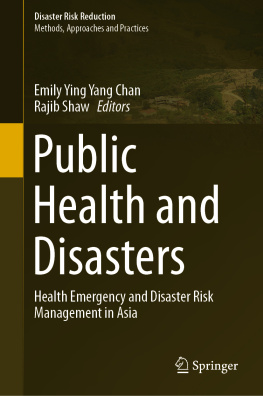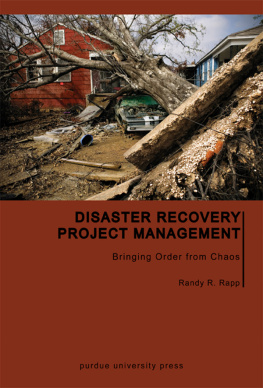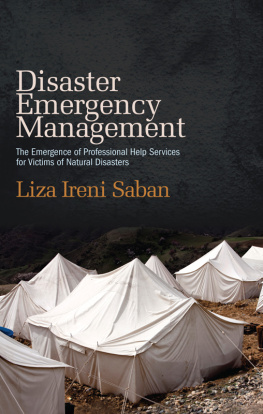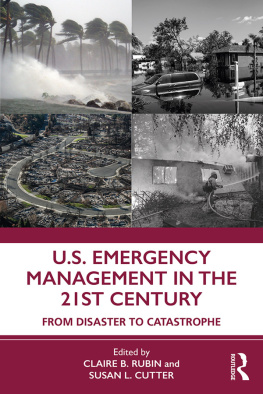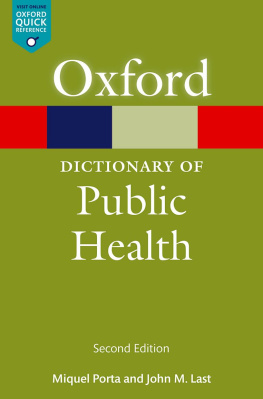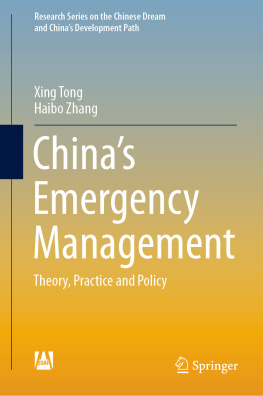Emily Ying Yang Chan (editor) - Public Health and Disasters : Health Emergency and Disaster Risk Management in Asia
Here you can read online Emily Ying Yang Chan (editor) - Public Health and Disasters : Health Emergency and Disaster Risk Management in Asia full text of the book (entire story) in english for free. Download pdf and epub, get meaning, cover and reviews about this ebook. year: 2020, genre: Politics. Description of the work, (preface) as well as reviews are available. Best literature library LitArk.com created for fans of good reading and offers a wide selection of genres:
Romance novel
Science fiction
Adventure
Detective
Science
History
Home and family
Prose
Art
Politics
Computer
Non-fiction
Religion
Business
Children
Humor
Choose a favorite category and find really read worthwhile books. Enjoy immersion in the world of imagination, feel the emotions of the characters or learn something new for yourself, make an fascinating discovery.
- Book:Public Health and Disasters : Health Emergency and Disaster Risk Management in Asia
- Author:
- Genre:
- Year:2020
- Rating:4 / 5
- Favourites:Add to favourites
- Your mark:
- 80
- 1
- 2
- 3
- 4
- 5
Public Health and Disasters : Health Emergency and Disaster Risk Management in Asia: summary, description and annotation
We offer to read an annotation, description, summary or preface (depends on what the author of the book "Public Health and Disasters : Health Emergency and Disaster Risk Management in Asia" wrote himself). If you haven't found the necessary information about the book — write in the comments, we will try to find it.
Public Health and Disasters : Health Emergency and Disaster Risk Management in Asia — read online for free the complete book (whole text) full work
Below is the text of the book, divided by pages. System saving the place of the last page read, allows you to conveniently read the book "Public Health and Disasters : Health Emergency and Disaster Risk Management in Asia" online for free, without having to search again every time where you left off. Put a bookmark, and you can go to the page where you finished reading at any time.
Font size:
Interval:
Bookmark:
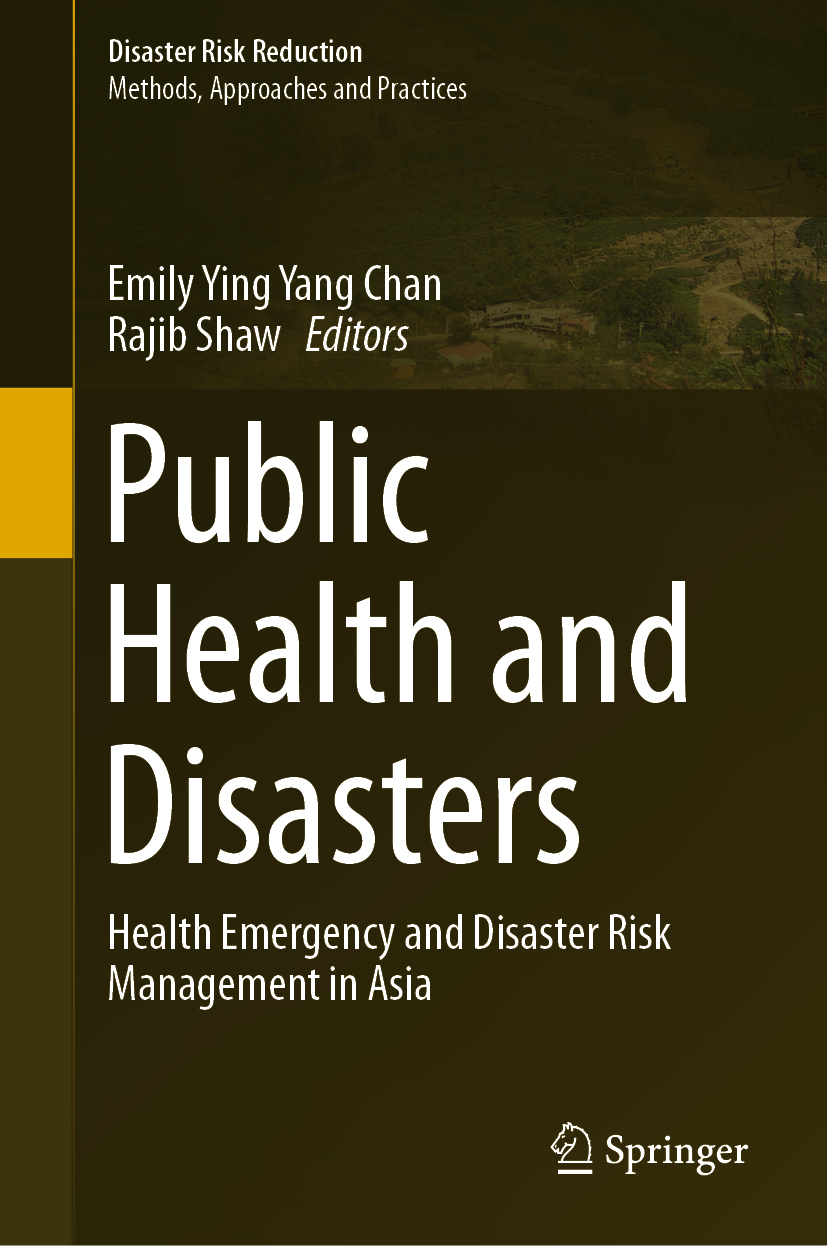
About the Series
Disaster risk reduction is a process that leads to the safety of communities and nations. After the 2005 World Conference on Disaster Reduction, held in Kobe, Japan, the Hyogo Framework for Action (HFA) was adopted as a framework for risk reduction. The academic research and higher education in disaster risk reduction has made, and continues to make, a gradual shift from pure basic research to applied, implementation-oriented research. More emphasis is being given to multi-stakeholder collaboration and multi-disciplinary research. Emerging university networks in Asia, Europe, Africa, and the Americas have urged process-oriented research in the disaster risk reduction field. With this in mind, this new series will promote the output of action research on disaster risk reduction, which will be useful for a wide range of stakeholders including academicians, professionals, practitioners, and students and researchers in related fields. The series will focus on emerging needs in the risk reduction field, starting from climate change adaptation, urban ecosystem, coastal risk reduction, education for sustainable development, community-based practices, risk communication, and human security, among other areas. Through academic review, this series will encourage young researchers and practitioners to analyze field practices and link them to theory and policies with logic, data, and evidence. In this way, the series will emphasize evidence-based risk reduction methods, approaches, and practices.
More information about this series at http://www.springer.com/series/11575

This Springer imprint is published by the registered company Springer Nature Singapore Pte Ltd.
The registered company address is: 152 Beach Road, #21-01/04 Gateway East, Singapore 189721, Singapore
Advancement in science technology in recent decades might have increased our capacity to tackle the adverse human consequences of various kinds of disasters, but the accompanied and interlinking modern phenomena of industrialisation, urbanisation, globalisation, climate change, and widening disparity have created new hazards and exacerbated the old ones, while aggravating peoples exposure to these hazards and worsening the vulnerability of the marginalised at the same time, notably in Asia as the most disaster-prone continent. In the face of this dire prospect, the effective, efficient, and synergetic use of available resources for disaster risk reduction could provide an answer. Arguably, human health, or its inadequacy, is an inevitable outcome of disaster, while its enhancement a natural goal of disaster risk reduction (DRR), as enshrined in the landmark United Nations agreements adopted in this decade, including the Sendai Framework for Disaster Risk Reduction 20152030, the 2030 Sustainable Development Goals (SDGs), the Paris climate agreement, and the New Urban Agenda (Habitat III). Targeting the health aspect of DRR is thus an obvious route to take. Under the cluster approach instituted by the United Nations in 2006, health is among the 11 key areas where clusters have been established, and the global health cluster is led by the World Health Organization (WHO). Nevertheless, the health sector has traditionally focused on the response to disasters and emergencies.
In recent years, prevention and mitigation have been gradually recognised as a more efficient approach to tackle the health risk associated with emergencies and disasters. Preparedness of the stakeholders and resilience of the health systems based on primary health care at community level to reduce exposure and vulnerability are key concepts and practices under this emerging approach, which means multi-sectoral actors and their coordination are crucial. Consequently, the WHO (2019) has launched the Health Emergency and Disaster Risk Management (Health-EDRM) framework to weave together health, DRR, and other relevant disciplines to fill the theoretical gap and meet the practical needs in the new scene of DRR, with prevention as the pivot in this framework.
Comprising of 9 chapters of theoretical discussion and 14 case studies, this book presents the theoretical framework of Health-EDRM, places it within the global institutional context, and illustrates it within concrete examples from Asia, namely Bangladesh, China, India, Japan, Nepal, Pakistan, Vietnam, and the Philippines. How these case studies can illuminate the Health-EDRM framework and field of study and practice will be summarised before the way forward is explored to wrap up this multi-sectoral dialogue.
This book is intended for advanced undergraduate and postgraduate students, researchers, policy makers, and practitioners in related fields of DRR who are interested in looking at DRR from health in general, as well as its application in Asia. Our special thank goes to Chi Shing Wong of CCOUC for his meticulous support and coordination of this book project, as well as the unfailing editorial support from Asami Komada, Mariko Komaru, Dinesh Natarajan, Yosuke Nishida, Umamagesh Perumal and Taeko Sato at Springer.
World Health Organization (2019) Health emergency and disaster risk management framework. World Health Organization, Geneva
Font size:
Interval:
Bookmark:
Similar books «Public Health and Disasters : Health Emergency and Disaster Risk Management in Asia»
Look at similar books to Public Health and Disasters : Health Emergency and Disaster Risk Management in Asia. We have selected literature similar in name and meaning in the hope of providing readers with more options to find new, interesting, not yet read works.
Discussion, reviews of the book Public Health and Disasters : Health Emergency and Disaster Risk Management in Asia and just readers' own opinions. Leave your comments, write what you think about the work, its meaning or the main characters. Specify what exactly you liked and what you didn't like, and why you think so.

